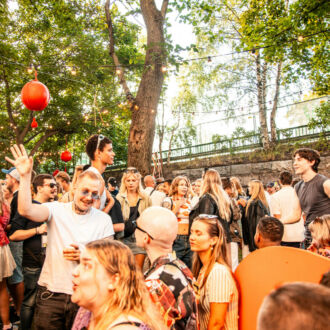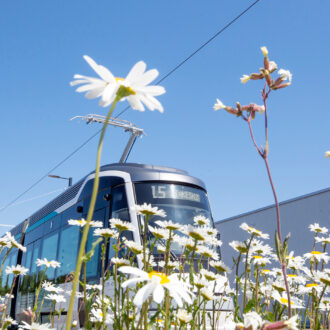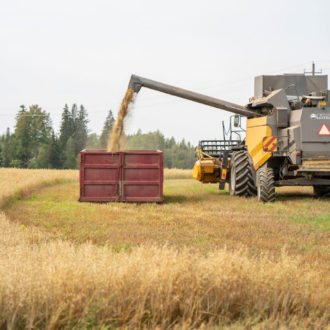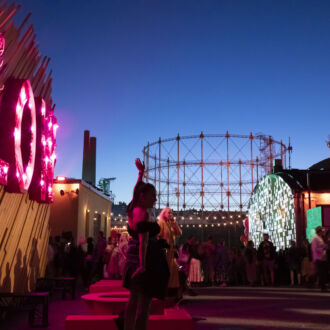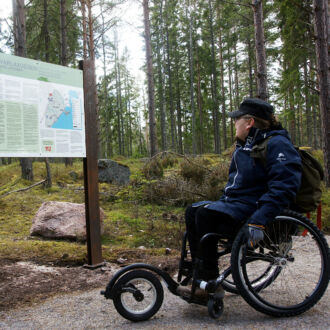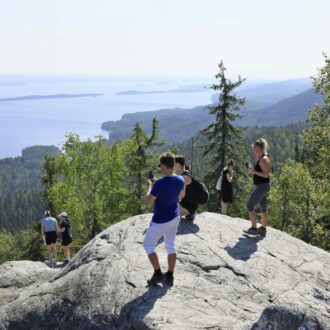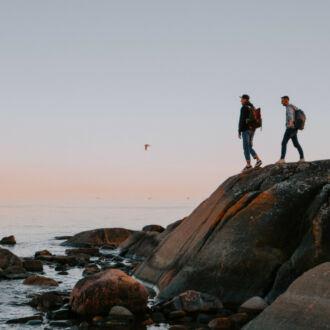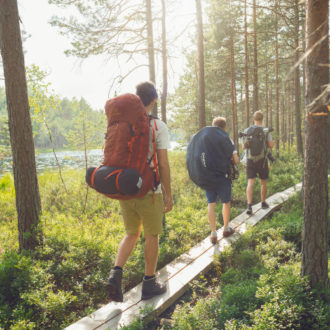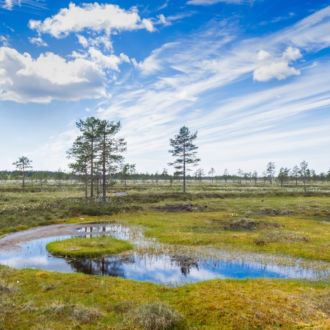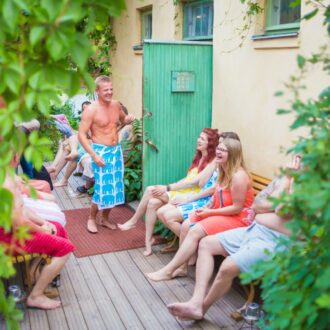Finland’s live music industry aims to be an international trailblazer in carbon neutrality. Industry groups including the Finland Festivals Association and the Association of Finnish Symphony Orchestras teamed up for a year-long study of the industry’s carbon footprint, cofunded by the Ministry of Education and Culture. In 2023 they unveiled their Cool Music climate roadmap at Helsinki’s G Livelab club.
Finland is committed to becoming carbon-neutral by 2035, so every sector of the economy is involved – not just heavy industry, but also “lighter” fields such as the arts. The live music roadmap calls for sweeping changes in how festivals and concerts are staged – and, crucially, how fans reach them.
Implementing and optimising

American composer and musician Caroline Shaw (centre) performed at Our Festival with the Kamus String Quartet at the studio museum of Pekka Halonen (1865–1933), a famous artist. Our Festival, a member of the Finland Festivals Association, has a long record of sustainability and is taking steps to become carbon-neutral by 2025.Photo: Maarit Kytöharju/Our Festival
An analysis of the existing situation set up a baseline for improvement, revealing that travel accounts for more than 70 percent of the sector’s emissions.
“The biggest emission sources are transport and purchases, including catering, marketing and performance technology,” says Sara Salminen of Positive Impact, a member of the roadmap team. It sets goals for 2030 and 2035 in four main areas: transport, energy, consumption and cultural changes.
“Concrete emission-cutting goals can be implemented immediately by optimising logistics and choosing plant-based foods for catering,” says Salminen.
“The 2030 goals include making plant-based food the norm across the music sector, as well as making climate-savvy choices to limit transport emissions, opting for renewable energy whenever possible and having all music industry operators commit to the shared climate mission.”
Smooth jazz touring
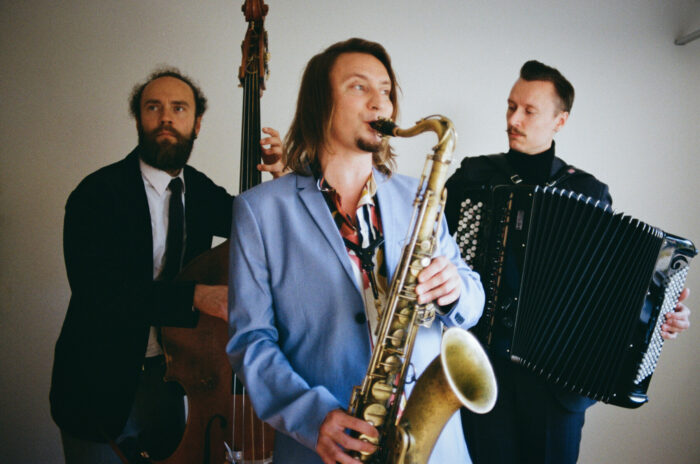
From left: Eero Tikkanen, Pauli Lyytinen and Harri Kuusijärvi are Sole Azul, which “rips tango out by the roots and plants it in the Nordic frozen soil,” they say on their website. They’ve been helping the Finnish Jazz Federation pioneer a low-carbon touring model.Photo: Aarni Toiviainen
The Finnish Jazz Federation, which organises gigs around Europe, has been pioneering a low-carbon touring model in recent years.
In 2022 the jazz-tango trio Sole Azul toured northern Finland by taking a train to Lapland, nearly 1,000 kilometres (620 miles) from their Helsinki base. They set up residence in a cabin in Kittilä and commuted by electric car to five concert sites, including several small villages.
“In a country the size of Finland, it’s practically impossible to be a professional performing artist without covering lots of territory and mileage,” says Harri Kuusijärvi, the group’s accordionist. “We hope carbon neutrality will soon be a given on tours.”
Jazz gigs tend to be simpler affairs than those of symphony orchestras or major rock bands, but the industry has been watching the jazz pilot project for ideas.
Culture and art in climate policy
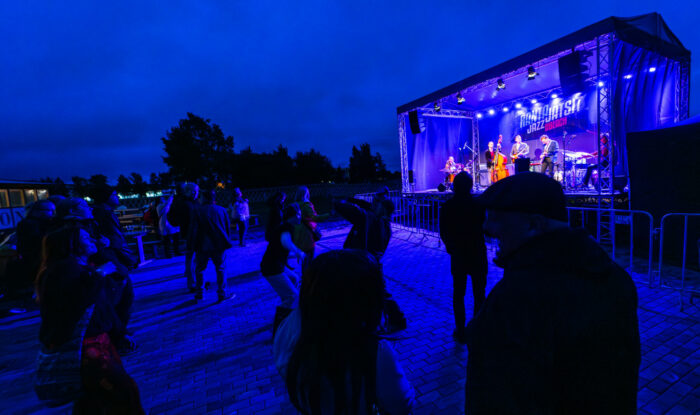
People listen and dance at Raahe Jazz on the Beach, whose organisers advocate “slow touring” by ship and train whenever possible.Photo: Ville Vainio/Raahe Jazz on the Beach
“Most artists, promoters and event organisers already had great interest in climate action before our project, but lacked concrete tools,” says Raisa Siivola, manager of the Jazz Federation’s touring project. “Most of them said they got useful information for improving their sustainability from the project.”
The biggest challenge, she says, is “turning plans into action. It’s hard to change your existing work or consumption culture. Another challenge is raising political awareness about supporting immaterial goods and services, such as culture and art, as a part of overall climate policy.”
According to Charles Gil, who produces international tours and directs the Raahe Jazz on the Beach festival, “there’s more awareness about the topic, but still so much to improve in practice.”
Bikes, buses and trains
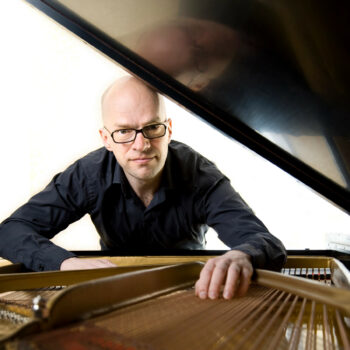
Esteemed jazz keyboardist Kari Ikonen is experimenting with concert tours that use only bike, bus and train transport.Photo: Tanja Ahola
Gil advocates “slow touring” by ship and train whenever possible. It not only reduces emissions, but also decreases musicians’ stress levels, so the audience also benefits. Gil also no longer brings foreign artists to Finland for one-off gigs.
“For the Raahe festival, we only book foreign artists if they’re on tour in Finland,” he says. “It’s more challenging, but the motivation is stronger to find more concerts elsewhere for a visiting artist you really want to get.”
In 2022, with booking support from Gil, acclaimed keyboardist Kari Ikonen made a month-long “Flight-free Zero-CO₂ European Solo Piano Tour” with 14 concerts in five countries, travelling mostly by train. His 2024 tour of the Baltic countries includes train, bus and e-bike.
Ikonen experimented with bicycle touring across southern Finland’s Uusimaa region in autumn 2020, when Covid restrictions kept audiences small. “That tour was great fun and attracted local media attention,” he says. “I was lucky with the weather – I only had to hang my clothes up to dry backstage once.”
By Wif Stenger, October 2023
